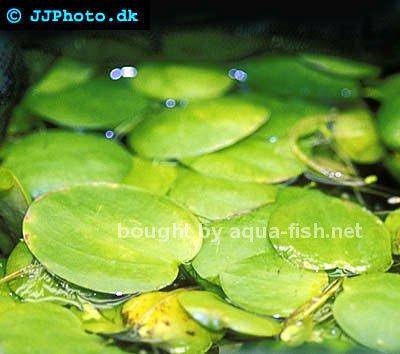Phyllanthus fluitans
Scientific name: Phyllanthus fluitans
Family: Euphorbiaceae
Maximum size reached under cultivation: 0 - 4 cm (0 - 1.57 inch)
014
Recommended pH range: 5.8 - 7
Recommended water hardness: 4 - 12°dGH (71.43 - 214.29ppm)
0°C 32°F30°C 86°F
Recommended temperature range: 21 - 30 °C (69.8 - 86°F)
Preferred propagation method: Divisions
Native to: South America
Growth rate: Normal
Recommended substrate: Without substrate
Lighting requirements: Bright
Ideal placement in tank: Floating
Family
Euphorbiaceae
Common Name
Red Root Floater
Propagation
Phyllanthus fluitans reproduces vegetatively through division. As the plant grows, it produces small side shoots or extensions that develop their own leaves and roots. These can be naturally separated or gently divided to form new floating clusters. It does not root in the substrate, and even small fragments with healthy nodes can continue growing under favorable conditions. Propagation is especially vigorous under strong lighting and stable water parameters.
Difficulty
Medium. While not difficult to grow, maintaining vibrant color and compact growth requires bright lighting, good water quality, and occasional thinning. In low light, the plant may lose its red hue and become pale green.
Short Description
Phyllanthus fluitans, commonly known as Red Root Floater, is a beautiful South American floating plant prized for its round, water-repellent leaves and striking reddish coloration. Its roots hang freely beneath the surface, forming a dense mat that provides excellent cover for fry and shrimp. The plant's small size—usually up to 4 cm (1.57 inches)—makes it suitable even for nano aquariums. Under bright light, its leaves take on shades of red or pink, and its roots deepen in color as well.
Because it floats on the surface, Phyllanthus fluitans should not be planted in substrate. It is ideal for open-top aquariums or setups with minimal surface agitation. Be careful not to let it cover too much of the water surface, as it can block light from reaching submerged plants below.
Maintenance and Care
This plant thrives at temperatures between 21–30°C (69.8–86°F), in soft to moderately hard water with a pH range of 5.8 to 7.0. Bright lighting is essential for vibrant coloration and compact growth. It does not require CO2 injection, but stable conditions and occasional nutrient supplementation in the water column help maintain its health. Surface flow should be kept low to prevent the plant from being pushed around or damaged.
Compatibility
Phyllanthus fluitans is compatible with peaceful fish and invertebrates, especially those that appreciate surface cover. It provides excellent shelter for fry and helps diffuse light in the tank. However, it may be eaten by herbivorous fish or disturbed by fish that jump or create strong surface movement. It is a great addition to nature-style, shrimp, and breeding tanks.
Submersion and Aquascaping
This is a true floating plant and should not be submerged or planted in the substrate. Its ornamental leaves create a natural, soft appearance on the water surface and contrast beautifully with stem or carpeting plants below. It is best used in aquascapes where surface aesthetics and fry protection are priorities. In open tanks, it adds a tranquil, pond-like atmosphere.
Picture
Bought by aqua-fish.net from jjphoto.dk
